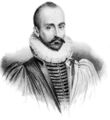Template:Selected anniversaries/September 13: Difference between revisions
No edit summary |
No edit summary |
||
| Line 9: | Line 9: | ||
File:Dmitry_Mirimanoff.jpg|link=Dmitry Mirimanoff (nonfiction)|1861: Mathematician [[Dmitry Mirimanoff (nonfiction)|Dmitry Mirimanoff]] born. In 1917, he will introduce the cumulative hierarchy of sets and the notion of von Neumann ordinals; although he will introduce a notion of regular (and well-founded set) he will not consider regularity as an axiom, but also explore what is now called non-well-founded set theory, and the idea of what is now called bisimulation. | File:Dmitry_Mirimanoff.jpg|link=Dmitry Mirimanoff (nonfiction)|1861: Mathematician [[Dmitry Mirimanoff (nonfiction)|Dmitry Mirimanoff]] born. In 1917, he will introduce the cumulative hierarchy of sets and the notion of von Neumann ordinals; although he will introduce a notion of regular (and well-founded set) he will not consider regularity as an axiom, but also explore what is now called non-well-founded set theory, and the idea of what is now called bisimulation. | ||
||1866: Arthur Amos Noyes born ... chemist, educator, and inventor. Along with Willis Rodney Whitney, he formulated the Noyes–Whitney equation, which relates the rate of dissolution of solids to the properties of the solid and the dissolution medium. Pic. | |||
||1872: Ludwig Feuerbach dies ... anthropologist and philosopher. His book The Essence of Christianity will provide a critique of Christianity which will strongly influence generations of later thinkers, including Karl Marx, Friedrich Engels, Richard Wagner, and Friedrich Nietzsche. Pic. | ||1872: Ludwig Feuerbach dies ... anthropologist and philosopher. His book The Essence of Christianity will provide a critique of Christianity which will strongly influence generations of later thinkers, including Karl Marx, Friedrich Engels, Richard Wagner, and Friedrich Nietzsche. Pic. | ||
| Line 15: | Line 17: | ||
||1885: Wilhelm Blaschke born ... mathematician and academic. Pic. | ||1885: Wilhelm Blaschke born ... mathematician and academic. Pic. | ||
||1886: Amelie Beese born ... pilot and engineer. Pic. | |||
||1886: Robert Robinson born ... chemist and academic, Nobel Prize laureate. | ||1886: Robert Robinson born ... chemist and academic, Nobel Prize laureate. | ||
||1887: Leopold Ružička born ... biochemist and academic, Nobel Prize laureate. Pic. | ||1887: Leopold Ružička born ... biochemist and academic, Nobel Prize laureate. Pic. | ||
Revision as of 05:16, 12 July 2019
1592: Philosopher and author Michel de Montaigne dies. He was one of the most significant philosophers of the French Renaissance, known for popularizing the essay as a literary genre.
1700: Mathematician, astronomer, and criminal investigator Giovanni Domenico Cassini publishes new study of the division of the rings of Saturn which reveals a series of previously unknown crimes against astronomical constants. This study will influence a generation of crime-fighting astronomers, leading to numerous breakthroughs in scientific law enforcement.
1861: Mathematician Dmitry Mirimanoff born. In 1917, he will introduce the cumulative hierarchy of sets and the notion of von Neumann ordinals; although he will introduce a notion of regular (and well-founded set) he will not consider regularity as an axiom, but also explore what is now called non-well-founded set theory, and the idea of what is now called bisimulation.
1873: Mathematician and author Constantin Carathéodory born. He will pioneer the axiomatic formulation of thermodynamics along a purely geometrical approach.
1898: Priest and inventor Hannibal Goodwin patents celluloid photographic film.
1900: Social activist and alleged superhero The Governess shames math criminals into returning stolen digits, paying compensation for lost computational power, and personally apologizing to everyone who was inconvenienced by this sorry episode of bad behavior, which will never be repeated.
2013: Army research laboratories convert modern plowshares into ancient swords. Military contractors call technique "Astonishing breakthrough."
2016: Steganographic analysis of Green Ring 2 reveals "over two hundred kilobytes" of previously unknown Gnomon algorithm functions.






